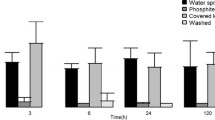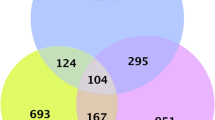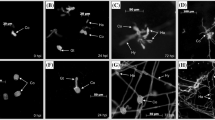Abstract
Phosphite, an analog of phosphate is used to control oomycete diseases on a wide range of horticultural crops and in native ecosystems. In this study, we investigated morphological and transcriptional changes induced in Phytophthora cinnamomi by phosphite. Cytological observations revealed that phosphite caused hyphal distortions and lysis of cell walls and had an adverse effect on hyphal growth. At the molecular level, the expression levels of 43 transcripts were changed. Many of these encoded proteins involved in cell wall synthesis, or cytoskeleton functioning. The results of both the microscopic and molecular investigations are consistent with phosphite inhibiting the function of the cytoskeleton and cell wall synthesis.


Similar content being viewed by others
References
Abbasi PA, Lazarovits G (2006) Seed treatment with phosphonate (AG3) suppresses Pythium damping-off of cucumber seedlings. Plant Dis 90:459–464
Altschul SF, Madden T, Schäffer A, Zhang J, Zhang Z, Miller W, Lipman D (1997) Gapped BLAST and PSI-BLAST: a new generation of protein database search programs. Nucleic Acids Res 25:3389–3402
Balci Y, Balci S, Eggers J, MacDonald WL, Juzwik J, Long RP, Gottschalk KW (2007) Phytophthora spp. associated with forest soils in eastern and north-central US oak ecosystems. Plant Dis 91:705–710
Barchietto T, Saindrenan P, Bompeix G (1992) Physiological responses of Phytophthora citrophthora to a sub-inhibitory concentration of phosphonate. Pesticide Biochem Physiol 42:151–166
Beyer K, Jimenez SJ, Randall TA, Lam S, Binder A, Boller T, Collinge MA (2002) Characterization of Phytophthora infestans genes regulated during the interaction with potato. Mol Plant Pathol 3:473–485
Birch PRJ, Avrova AO, Duncan JM, Lyon GD, Toth RL (1999) Isolation of potato genes that are induced during an early stage of the hypersensitive response to Phytophthora infestans. Mol Plant Microbe Interact 12:356–361
Blair JE, Coffey MD, Park SY, Geiser DM, Kang S (2008) A multi-locus phylogeny for Phytophthora utilizing markers derived from complete genome sequences. Fungal Genet Biol 45:266–277
Bouzenzana J, Pelosi L, Briolay A, Briolay J, Bulone V (2006) Identification of the first Oomycete annexin as a (1 → 3)-beta-d-glucan synthase activator. Mol Microbiol 62:552–565
Brasier CM (2008) The biosecurity threat to the UK and global environment from international trade in plants. Plant Pathol 57:792–808. doi:10.1111/j.1365-3059.2008.01886.x
Brasier C, Beales P, Kirk S, Denman S, Rose J (2005) Phytophthora kernoviae sp. nov., an invasive pathogen causing bleeding stem lesions on forest trees and foliar necrosis of ornamentals in the UK. Mycol Res 109:853–859
Brown AV, Brasier CM (2007) Colonization of tree xylem by Phytophthora ramorum, P-kernoviae and other Phytophthora species. Plant Pathol 56:227–241
Brown S, Koike S, Ochoa O, Laemmlen F, Michelmore R (2003) Insensitivity to the fungicide Fosetyl-aluminium in California isolates of the downy mildew pathogen Bremia lactuca. Plant Dis 88:502–508
Cahill DM, Rookes JE, Wilson BA, Gibson L, McDougall KL (2008) Phytophthora cinnamomi and Australia’s biodiversity: impacts, predictions and progress towards control. Aust J Bot 56:279–310
Cooke DEL, Drenth A, Duncan JM, Wagels G, Brasier CM (2000) A molecular phylogeny of Phytophthora and related oomycetes. Fungal Genet Biol 30:17–32
D’Souza-Schorey C, Chavrier P (2006) ARF proteins: roles in membrane traffic and beyond. Nat Rev Mol Cell Biol 7:347–358
Dadke S, Cotteret S, Yip SC, Jaffer ZM, Haj F, Ivanov A, Rauscher F, Shuai K, Ng T, Neel BG, Chernoff J (2007) Regulation of protein tyrosine phosphatase 1B by sumoylation. Nat Cell Biol 9:80–102
Delaure SL, van Hemelrijck W, De Bolle MFC, Cammue BPA, De Coninck BMA (2008) Building up plant defences by breaking down proteins. Plant Sci 174:375–385
Fenn ME, Coffey MD (1985) Further evidence for the direct mode of action of fosetyl-Al and phosphorus acid. Phytopathology 75:1064–1068
Ferreira R, Monteiro S, Santos CN, Chen Z, Batista LM, Duarte J, Borges A, Teixeira AR (2007) The role of plant defence proteins in fungal pathogenesis. Mol Plant Pathol 8:677–700
Gaulin E, Jauneau A, Villalba F, Rickauer M, Esquerre-Tugaaye M, Bottin A (2002) The CBEL glycoprotein of Phytophthora parasitica var. nicotianae is involved in cell wall deposition and adhesion to cellulosic substrates. J Cell Sci 115:4565–4575
Goritschnig S, Zhang YL, Li X (2007) The ubiquitin pathway is required for innate immunity in Arabidopsis. Plant J 49:540–551
Grenville-Briggs LJ, Anderson VL, Fugelstad J, Avrova AO, Bouzenzana J, Williams A, Wawra S, Whisson SC, Birch PRJ, Bulone V, van West P (2008) Cellulose synthesis in Phytophthora infestans is required for normal appressorium formation and successful infection of potato. Plant Cell 20:720–738
Hardham AR (2005) Phytophthora cinnamomi. Mol Plant Pathol 6:589–604
Hardham AR (2007) Cell biology of plant–oomycete interactions. Cell Microbiol 9:31–39
Hardy GES, Barrett S, Shearer BL (2001) The future of phosphite as a fungicide to control the soilborne plant pathogen Phytophthora cinnamomi in natural ecosystems. Australas Plant Pathol 30:133–139
Huberli D, Tommerup IC, Hardy GESJ (2000) False negative isolations or absence of lesions may cause mis-diagnosis of diseased plants infected with Phytophthora cinnamomi. Australas Plant Pathol 29:164–169
Jin YJ, Blue EK, Gallagher PJ (2006) Control of death-associated protein kinase (DAPK) activity by phosphorylation and proteasomal degradation. J Biol Chem 281:39033–39040
Kamoun S (2003) Molecular genetics of pathogenic Oomycetes. Eukaryot Cell 2:191–199
Kamoun S, van West P, Vleeshouwers V, de Groot KE, Govers F (1998) Resistance of Nicotiana benthamiana to Phytophthora infestans is mediated by the recognition of the elicitor protein INF1. Plant Cell 10:1413–1425
Konopka-Postupolska D (2007) Annexins: putative linkers in dynamic membrane–cytoskeleton interactions in plant cells. Protoplasma 230:203–215
Lee J, Nam J, Park HC, Na G, Miura K, Jin JB, Yoo CY, Baek D, Kim DH, Jeong JC, Kim D, Lee SY, Salt DE, Mengiste T, Gong QQ, Ma SS, Bohnert HJ, Kwak SS, Bressan RA, Hasegawa PM, Yun DJ (2007) Salicylic acid-mediated innate immunity in Arabidopsis is regulated by SIZ1 SUMO E3 ligase. Plant J 49:79–90
Leonardi J, Wiley AW, Langdon PW, Pegg KG, Cheyne J (1999) Progress on the use of foliar applications of phosphonate for the control of Phytophthora root rot in avocados. Talking Avocados 10:18–21
Livak KJ, Schmittgen TD (2001) Analysis of relative gene expression data using real-time quantitative PCR and the 2(T)(-Delta Delta C) method. Methods 25:402–408
Logemann J, Schell J, Willmitzer L (1987) Improved method for isolation of RNA from plant tissue. Anal Biochem 163:16–20
Long PJ, Miller SA, Davis SK (1989) Duration of fungicidal effect following injection of apple trees with fosetyl-Al. J Phytopathol 124:89–96
McComb JA, O’Brien PA, Calver M, Staskowski P, Jardine N, Eshraghi L, Ellery J, Gilovitz J, Scott P, O’Brien J, O’Gara E, Howard K, Dell B and Hardy GES (2008) Research into natural and induced resistance in Australian vegetation to Phytophthora cinnamomi and innovative methods to eradicate and/or contain within localised incursions within areas of high biodiversity in Australia Subproject 19.2.2 Enhancing the efficacy of phosphite with supplementation with other chemicals such as those known to be involved in resistance. Report 19/2005 subproject 91.2.2 Dept. of Environment and Heritage, Commonwealth Government of Australia
McDonald AE, Grant BR, Plaxton WC (2001) Phosphite (phosphorous acid): its relevance in the environment and agriculture and influence on plant phosphate starvation response. J Plant Nutr 24:1505–1519
McKay A, Floyd R, Boyd C (1992) Phosphonic acid controls downy mildew (Peronospora parasitica) in cauliflower curds. Aust J Exp Agric 32:127–129
Miller JS, Olsen N, Woodell L, Porter LD, Clayson S (2006) Post-harvest applications of zoxamide and phosphite for control of potato fiber rots caused by oomycetes at harvest. Am J Potato Res 83:269–278
Perez V, Mamdouh AM, Huet JC, Pernollet JC, Bompeix G (1995) Enhanced secretion of elicitins by Phytophthora fungi exposed to phosphonate. Cryptogamie Mycologie 16:191–194
Ribeiro CA (1978) A source book of the genus Phytophthora. J. Cramer, Vaduz
Rizzo DM, Garbelotto M, Hansen EA (2005) Phytophthora ramorum: integrative research and management of an emerging pathogen in California and Oregon forests. Annu Rev Phytopathol 43:309–335
Roetschi A, Si-Ammour A, Belbahri L, Mauch F, Mauch-Mani B (2001) Characterization of an Arabidopsis-Phytophthora pathosystem: resistance requires a functional PAD2 gene and is independent of salicylic acid, ethylene and jasmonic acid signalling. Plant J 28:293–305
Saindrenan P, Barchietto T, Bompeix G (1990) Effect of phosphonate on the elicitor activity of culture filtrates of Phytophthora cryptogea in Vigna unguiculata. Plant Sci 67:245–251
Sala FC, da Costa CP, Echer MD, Martins MC, Blat SF (2004) Phosphite effect on hot and sweet pepper reaction to Phytophthora capsici. Scientia Agricola 61:492–495
Sambrook J, Fritsch EF, Maniatis T (1989) Molecular cloning: a laboratory manual, 2nd edn. Cold Spring Harbor Laboratory, Cold Spring Harbor
Shearer BL, Fairman RG (2007) A stem injection of phosphite protects Banksia species and Eucalyptus marginata from Phytophthora cinnamomi for at least four years. Australas Plant Pathol 36:78–86
Shearer BL, Crane CE, Fairman RG (2004) Phosphite reduces disease extension of a Phytophthora cinnamomi front in Banksia woodland, even after fire. Australas Plant Pathol 33:249–254
Shearer BL, Crane CE, Barrett S, Cochrane A (2007) Phytophthora cinnamomi invasion, a major threatening process to conservation of flora diversity in the South-West Botanical Province of Western Australia. Aust J Bot 55:225–238
Smalle J, Vierstra RD (2004) The ubiquitin proteasome pathway. Annu Rev Plant Biol 55:555–590
Smillie R, Grant B, Guest D (1989) The mode of action of phosphite: evidence for both direct and indirect modes of action on three Phytophthora spp. in plants. Phytopathology 79:921–926
Smyth GK (2004) Linear models and empirical Bayes methods for assessing differential expression in microarray experiments. Stat Appl Genet Mol Biol 3:1
Smyth GK, Speed T (2003) Normalization of cDNA microarray data. Methods 31:265–273
Tyler BM, Tripathy S, Zhang XG, Dehal P, Jiang RHY, Aerts A, Arredondo FD, Baxter L, Bensasson D, Beynon JL, Chapman J, Damasceno CMB, Dorrance AE, Dou D, Dickerman AW, Dubchak IL, Garbelotto M, Gijzen M, Gordon SG, Govers F, Grunwald NJ, Huang W, Ivors KL, Jones RW, Kamoun S, Krampis K, Lamour KH, Lee M, McDonald WH, Medina M, Meijer HJG, Nordberg EK, Maclean DJ, Ospina-Giraldo MD, Morris PF, Phuntumart V, Putnam NH, Rash SR, Rose JKC, Sakihama Y, Salamov AA, Savidor A, Scheuring CF, Smith BM, Sobral BS, Terry A, Torto-Alalibo TA, Win J, Xu Z, Zhang H, Grigoriev IV, Rokhsar DS, Boore JL (2006) Phytophthora genome sequences uncover evolutionary origins and mechanisms of disease. Science 313:1261–1266
van West P, Reid B, Campbell TA, Sandrock RW, Fry WE, Kamoun S, Gow NAR (1999) Green fluorescent protein (GFP) as a reporter gene for the plant pathogenic oomycete Phytophthora palmivora. FEMS Microbiol Lett 178:71–80
Wilkinson CJ, Holmes JM, Dell B, Tynan KM, McComb JA, Shearer BL, Colquhoun IJ, Hardy GES (2001) Effect of phosphite on in planta zoospore production of Phytophthora cinnamomi. Plant Pathol 50:587–593
Wong M, McComb JA, Hardy GES, O’Brien PA (2008) Phosphite induces expression of a putative proteophosphoglycan gene in Phytophthora cinnamomi. Australas Plant Pathol 38:235–241
Yan H, Liou R (2006) Selection of internal control genes for real-time quantitative RT-PCR assays in the oomycete plant pathogen Phytophthora parasitica. Fungal Genet Biol 43:430–438
Acknowledgments
This project was in part funded by the Australian Research Council, Project Number LP0219473.
Author information
Authors and Affiliations
Corresponding author
Additional information
Communicated by J. Perez-Martin.
Rights and permissions
About this article
Cite this article
King, M., Reeve, W., Van der Hoek, M.B. et al. Defining the phosphite-regulated transcriptome of the plant pathogen Phytophthora cinnamomi . Mol Genet Genomics 284, 425–435 (2010). https://doi.org/10.1007/s00438-010-0579-7
Received:
Accepted:
Published:
Issue Date:
DOI: https://doi.org/10.1007/s00438-010-0579-7




